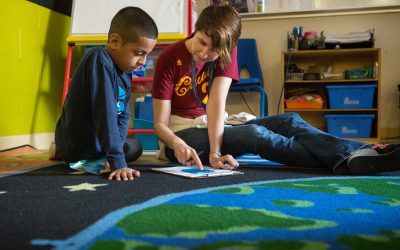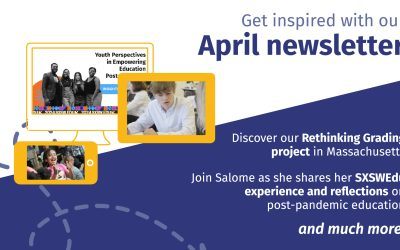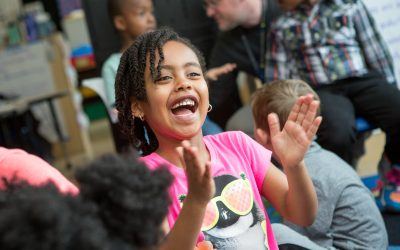No matter what kind of system you teach in – assessment – knowing what your students know and are able to do – is essential to understanding what students are learning. In mastery-based systems, in particular, where the focus shifts from time-based completion to certifying that each learner reaches a designated level of mastery (or proficiency, competency, performance!), assessment functions as an anchor to the overall quality of the system itself.
Performance assessment plays an important role in generating evidence of deeper understanding and a student’s ability to apply what they know in authentic contexts. Moreover, when a cycle of performance assessment is established, the process through which students practice and incorporate feedback elevates the role of assessment for and as learning, placing assessment as an integral part of the instructional and learning process (and not as something that only happens at the end to document learning). As with other aspects of mastery education, there is a range of what assessment looks like across different schools and districts. Across systems we can look for evidence of a set of key qualities and processes to reflect on the quality of our assessments: alignment to the competencies and learning goals at the intended depth of understanding, accessibility and clarity, fairness to different learners, a process for calibration to ensure consistency and reliability of the inferences we make when evaluating student work.
So how do you get started in designing mastery assessments?
Here I’ll offer two approaches to assessment design that we use at reDesign, the first is to design a common task frame aligned to a key competency, and the second is to begin with the design of an engaging and relevant problem frame. Embedded within each of these approaches is a learning cycle, based on the learning sciences, that supports the sequence and structure of the task. The learning cycle we use helps learners make meaning and connect to what they know already, investigate new concepts and skills in order to add to their schema of what they know, and then to create something original to share with others using those new ideas and skills. In other words, the tasks make the learning processes visible.
Common task frames
In this approach, the entry point is the transferable skills of the competencies. The task is designed in order for students to produce evidence of the competencies multiple times with different content and contexts, allowing the learner to practice and develop a body of evidence of their mastery of the competency. Examples of common task frames that fall under communication and expression competencies include developing an argument, delivering a speech, narrative writing, and multimedia presentations. Examples of common task frames aligned to scientific inquiry, problem solving, and quantitative reasoning include engineering design, mathematical modeling, and experimental design
The design process for common task frames begins with unpacking the components of the target competencies to distill the underlying thinking processes and the criteria for quality outcomes. The same process and criteria can be applied when the task is used with different topics and scenarios.
Resources and examples:
- reDesign’s Design Lab Performance Tasks provide the building blocks for a number of different products aligned to key college and career ready competencies. These tools can be used to craft your own student facing performance task guides.
- Example multimedia student performance task guide: This task is designed to be used with a wide range of content, either in conjunction with course curriculum or as student selected tasks to demonstrate learning in an area of interest. Once the student has some experience with the steps in this kind of task, the student-facing performance task guide and accompanying project journal helps students undertake tasks without being completely dependent on the teacher.
- The Know Your Rights Participatory Youth Action Research documentary film site is a resource hub with a Project Blueprint and 30 Learning Experiences resources that map out and provide guidance to teachers throughout the project, from topic selection to the rough cut screening to taking authentic action. There are multiple directions students can explore and content resources on specific topics illustrate possible problem frames, which I address next.
Problem Frames
The problem frame design approach fits well with project-based learning pedagogy and systems in which students explore thematic curricula as a cohort. The entry point into the task often takes the form of a provocative and relevant, open-ended question for inquiry: How secure is our food system? Why do people protest? How does disease spread?
The design process begins with asking what students care about and what relevant issues are being discussed. Next, a topic question is honed to be viable in terms of accessibility, manageable depth and breadth, and connection to the competencies. The designer asks and answers questions such as: What are the core concepts that one needs to understand to explore this idea? What thinking skills can students apply as they investigate and respond to what they learn? What are meaningful products and performances and who are the audiences for these responses?
Resources and examples:
- reDesign’s Problem Frame Design Guide: A step by step process with prompts and examples to design and guide inquiry around an engaging and relevant problem or essential question.
- Buck Institute Out of the Gate projects: Example performance tasks embedded within a project based learning framework.
- Food Matters performance task and learning modules: A task that highlights both a problem-based frame and the “thinking blocks” of the task frames. Explore the student project overview sheet and accompanying scaffolded formative tasks. The rubric example is based from a competency continuum and there are student-facing modules built around the learning cycle.
These two approaches can get to many of the same learner experiences. When students choose a focus for a common task, they will hopefully select something relevant and meaningful to them. As students engage in exploring engaging and relevant themes and issues through a problem frame, they will in turn create products, solutions, and performances that align to the transferable skills of the target competencies. There are also hybrid approaches, such as the Center for Collaborative Education’s Quality Performance Assessment Rapid Prototyping process which begins with a target competency and a brainstorm of the real world contexts in which one would create products that demonstrate the competency.
Whichever approach you take to designing mastery assessments, we encourage you to use a collaborative process with colleagues either during the design or to receive feedback that your assessment meets the key quality criteria. Once you have one or more mastery assessments you are ready what’s next. At the practice level, the next step is to design the learning experiences that provide each student the opportunity to learn and practice the needed thinking skills to successfully create a response to the assessment – a learning cycle is a helpful tool in this step. At the systems level, you’ll need to design guidelines for a set of assessments that together provide the evidence you need to make decisions about each student’s readiness for their next chapter in education, work, and life.
Join the community!
Sign up to receive our newsletter, access best-of educational resources, and stay in the know on upcoming events and learning opportunities. We hope to see you soon!










